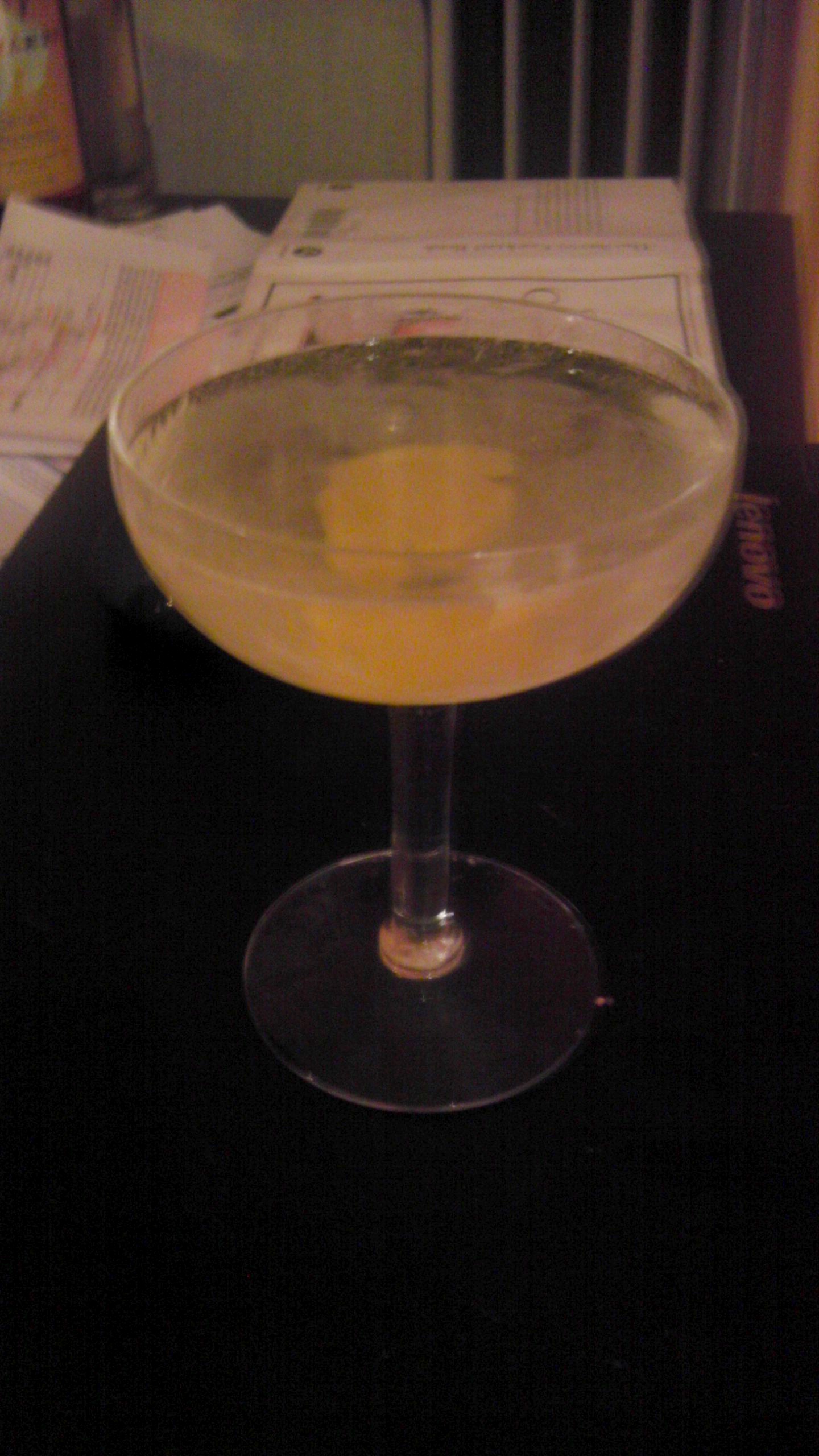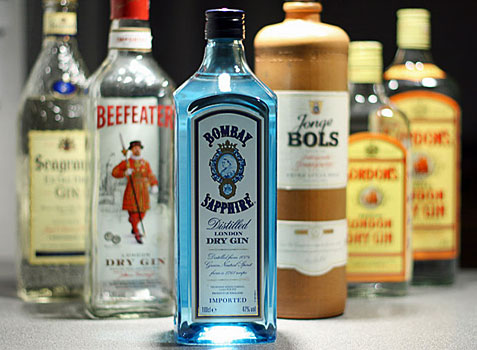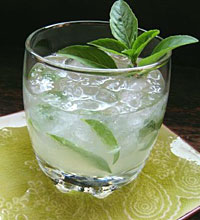Drink of the Week: The Ford Cocktail, Version 2
 As I tried to rescue the Ford Cocktail for a second week in row from my own mixed feelings, at times I was tempted just declare victory and move on,a la Vietnam. I am, instead, prepared to declare the coupe half-full with a sweeter version of the drink I actually like a bit better.
As I tried to rescue the Ford Cocktail for a second week in row from my own mixed feelings, at times I was tempted just declare victory and move on,a la Vietnam. I am, instead, prepared to declare the coupe half-full with a sweeter version of the drink I actually like a bit better.
There’s just no point in fighting the the fact that sweetened Old Tom Gin and megasugary hazelnut liqueur Benedictine are just destined to pound the hell out of even the finest dry vermouth. I give in and declare that I actually kind of like this drink, though it will never be a personal favorite. It’s definitely a more accessible improvement over last week’s even sweeter traditional version. In addition, I’ve made what I think are a few minor improvements in a version of the drink promulgated online at Imbibe by Chicago bartender Stephen Cole
The Ford Cocktail, Version 2
2 ounces Old Tom Gin
1 ounce dry vermouth
1/2 tablespoon (1/4 ounce) Benedictine
2-3 dashes orange bitters
1 orange twist (garnish)
Combine everything but the orange twist in a cocktail shaker with plenty of ice. Mr. Cole thinks you should stir this drink but I say you should shake it most vigorously. Then, strain it into a coupe or martini-style cocktail glass. You can add your orange twist in the traditional way — rimming the glass, twisting the orange peel over the drink to express the oils onto the surface of the beverage and then dropping the peel into the drink. Or, as Cole has it, you can discard the orange peel. I didn’t see much difference.
Enjoy your drink and toast second chances. Even when they don’t exactly produce perfection, they’re a reminder that life really does go on.
****
I kept fiddling with the proportions of this version of the Ford Cocktail, trying to fight what initially struck me as excessive sweetness, and got exactly no place. 1/4 of an ounce (1/2 tablespoon) of Benedictine became just one teaspoon and then 1/2 half a teaspoon. The drink lost sweetness but gained neither charm nor balance. Yet, when I returned to the original Cole formulation, I gradually grew to accept, if not exactly love, the Ford.
Still, I have to differ with the Cole recipe in a couple of respects. It specifically calls out the high-end Dolin’s for its dry vermouth. I like Dolin’s quite a bit, but I found the drink might actually have been improved by the more standard, much cheaper, and slightly dryer Martini & Rossi. I usually prefer slightly more flavorful dry vermouths but, for this drink, the crispness of Martini may win.
I win as well, because I finally get to move on to another drink, and I think it might be one I not only kinda invented myself but actually like. Stay tuned.
You can follow us on Twitter and Facebook for content updates. Also, sign up for our email list for weekly updates and check us out on Google+ as well.
Posted in: Food & Drink, Lifestyle, Vices
Tags: Benedictine, cocktails, Drink of the Week, Happy Hour, old Tom gin, orange bitters, The Ford Cocktail

 Happy July 4! I wish I could say I have a drink that’s a perfect salute to the ol’ red, white, and blue. Honestly, however, today’s drink has no particular connection with the holiday or even the auto manufacturer it shares a name with, nor even its enterprising, infamously antisemitic founder. It’s also a drink that, at this point, I have to say I’ve found to be just kind of okay. But I still haven’t given up and will even be revisiting the Ford Cocktail in another iteration very soon.
Happy July 4! I wish I could say I have a drink that’s a perfect salute to the ol’ red, white, and blue. Honestly, however, today’s drink has no particular connection with the holiday or even the auto manufacturer it shares a name with, nor even its enterprising, infamously antisemitic founder. It’s also a drink that, at this point, I have to say I’ve found to be just kind of okay. But I still haven’t given up and will even be revisiting the Ford Cocktail in another iteration very soon. As start to I write this, I’ve just finished watching the third presidential debate and I’m contemplating the power of the Etch-a-Sketch. Just as Mitt Romney somehow made a significant slice of the electorate forget everything that happened prior to debate #1, now left-leaners like your humble tippler are hoping debates #2 and #3 will make everyone forget that first one.
As start to I write this, I’ve just finished watching the third presidential debate and I’m contemplating the power of the Etch-a-Sketch. Just as Mitt Romney somehow made a significant slice of the electorate forget everything that happened prior to debate #1, now left-leaners like your humble tippler are hoping debates #2 and #3 will make everyone forget that first one.
 Gin is distilled from grain, usually wheat or rye, and starts out as a fairly plain spirit probably not so different from vodka. After that, “distilled gins” are then distilled a second time with various flavorings. The most prominent being juniper berries. That’s only for starters, as gin manufacturers use a pretty vast assortment of herbs and other botanicals ranging from licorice root to grapefruit peels to the perfumey bergamot we associate with Earl Grey tea. Some ultra-cheap brands are “compound gins.” These gins are not redistilled, but simply have tiny infusions added — they’re basically gin-flavored alcohol.
Gin is distilled from grain, usually wheat or rye, and starts out as a fairly plain spirit probably not so different from vodka. After that, “distilled gins” are then distilled a second time with various flavorings. The most prominent being juniper berries. That’s only for starters, as gin manufacturers use a pretty vast assortment of herbs and other botanicals ranging from licorice root to grapefruit peels to the perfumey bergamot we associate with Earl Grey tea. Some ultra-cheap brands are “compound gins.” These gins are not redistilled, but simply have tiny infusions added — they’re basically gin-flavored alcohol.








